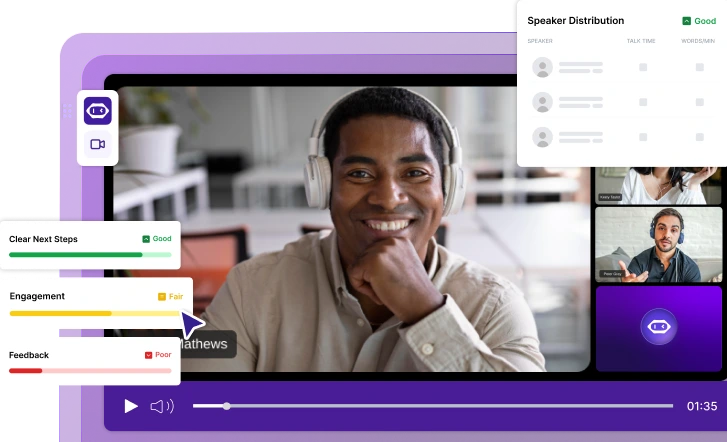Como Realizar uma Reunião de Descoberta Eficaz
Saiba como realizar uma reunião de descoberta eficaz com dicas e estratégias práticas que garantem o sucesso.

✅ Free meeting recording & transcription
💬 Automated sharing of insights to other tools.

Fonte da imagem: suco vetorial em Freepik
Realizar uma reunião de descoberta bem-sucedida é uma das etapas mais importantes na construção de relacionamentos sólidos com os clientes e na compreensão real de suas necessidades. Se você está trabalhando em um novo projeto ou refinando um existente, essas reuniões estabelecem a base para o sucesso.
Mas como você garante que suas reuniões de descoberta sejam produtivas e deixem todos na mesma página? Neste guia, apresentaremos dicas e estratégias práticas para ajudá-lo a realizar uma reunião de descoberta eficaz que não apenas reúna as informações certas, mas também fortaleça a confiança de seus clientes. Vamos começar!
O que é uma reunião de descoberta?
Uma reunião de descoberta é uma conversa inicial entre representantes de uma empresa ou equipe de vendas e um cliente. O objetivo da reunião é obter informações sobre as necessidades, metas e desafios do cliente.
É uma chance para ambas as partes se conhecerem e determinarem se há um bom ajuste entre as necessidades do cliente e os serviços oferecidos, estabelecendo as bases para uma parceria duradoura.
Reunião de descoberta de clientes versus reunião de descoberta de clientes
UM reunião de descoberta de clientes está focado em entender as necessidades e metas específicas de um cliente em potencial que possa estar interessado em seus serviços. Trata-se de construir um relacionamento e oferecer soluções que correspondam à sua situação única.
Em contraste, um reunião de descoberta de clientes é mais sobre aprender com clientes em potencial para obter feedback sobre uma ideia de produto ou serviço. É frequentemente usado durante o desenvolvimento do produto para garantir que você atenda às necessidades do mercado.
Embora ambas as reuniões ajudem você a aprender, a descoberta de clientes é orientada a serviços, e a descoberta de clientes tem mais a ver com moldar produtos com base nas percepções do cliente.
Por que as reuniões do Discovery são importantes?
As reuniões de descoberta de clientes são essenciais porque descrevem as expectativas, criam confiança, identificam os principais objetivos, destacam os desafios potenciais e estabelecem uma base sólida para a execução bem-sucedida do projeto.
Veja por que você precisa realizar reuniões de descoberta:
- Descrevendo expectativas: Uma reunião de descoberta produtiva garante que todos estejam na mesma página em relação ao escopo, cronogramas e resultados do projeto. Isso ajuda a evitar mal-entendidos mais tarde no processo.
- Construindo confiança: Quando você dedica um tempo para ouvir as preocupações e ideias de seus clientes, isso mostra que você investe no sucesso deles. Isso gera confiança e define um tom colaborativo para o resto do projeto.
- Identificação dos principais objetivos: As reuniões do Discovery permitem que você identifique as principais metas do cliente e como o sucesso será medido. Conhecer esses objetivos desde o início ajuda a moldar sua estratégia e mantém o projeto focado.
- Identificando possíveis desafios: Ao discutir o projeto em detalhes, você pode identificar possíveis obstáculos ou desafios que possam surgir. Isso permite que você resolva esses problemas de forma proativa.
- Estabelecendo uma base sólida: Em última análise, uma reunião de descoberta de clientes potenciais estabelece uma base sólida para o projeto. Isso ajuda você e seu cliente a se sentirem confiantes sobre as próximas etapas, minimizando o risco de falhas de comunicação ou surpresas futuras.
Qual é o momento certo para agendar uma reunião do Discovery?
O melhor momento para agendar uma reunião de descoberta é logo no início de um novo projeto ou parceria. Idealmente, essa reunião deve ocorrer após suas conversas iniciais com o cliente, mas antes do início de qualquer planejamento formal do projeto..
NOTA: Tente realizar a reunião com antecedência suficiente para capturar os principais insights e requisitos, mas não tão cedo que as partes interessadas essenciais não tenham a chance de se envolver. Dessa forma, você pode definir expectativas claras e reunir as informações necessárias para seguir em frente com confiança.
Quem deve realizar uma reunião de descoberta com um cliente?
No comando da reunião de descoberta, deve haver alguém que entenda as necessidades do cliente e as capacidades internas de sua equipe. Normalmente, isso seria um gerente de projeto, gerente de contas, ou representante de vendas que podem fazer as perguntas certas, orientar a conversa e garantir que nenhum detalhe crítico seja esquecido.
Também é útil ter os principais membros da equipe presentes, como um especialista técnico ou gerente de produto, para que eles possam oferecer insights e detalhes relevantes para suas áreas específicas de especialização.
Como se preparar para uma sessão inicial de descoberta
Você pode tomar várias medidas antes da reunião inicial para garantir que a conversa siga na direção certa, aumentando suas chances de um processo de descoberta bem-sucedido.
Veja como se preparar para uma sessão inicial de descoberta:
- Pesquise seus clientes potenciais e seus negócios
- Decida os objetivos da reunião
- Entre em contato com uma mensagem concisa
- Prepare perguntas abertas
- Envolva as pessoas certas
- Crie a agenda da reunião de descoberta
- Prepare-se para responder perguntas difíceis
- Prepare-se para a resistência de clientes potenciais
1. Pesquise seus clientes potenciais e seus negócios
A preparação adequada é fundamental para realizar uma reunião de descoberta bem-sucedida, e isso começa com a pesquisa de seu cliente potencial e de seus negócios.
Veja como você pode pesquisar seus clientes potenciais para uma sessão de descoberta bem-sucedida:
- Entenda seu setor: Comece pesquisando o setor em que operam. Veja as tendências, desafios e oportunidades atuais nesse espaço. Isso ajuda você a falar o idioma deles e a entender melhor o ambiente de negócios.
- Analise seus negócios: Visite o site, leia o blog e confira as notícias ou atualizações recentes sobre a empresa. Preste atenção aos produtos ou serviços, ao tamanho da empresa, ao público-alvo e à missão para obter contexto sobre suas metas e áreas nas quais eles poderiam usar o suporte.
- Examine seus concorrentes: analise seus concorrentes para identificar onde seu cliente potencial pode querer se diferenciar e quais desafios ele pode estar enfrentando no mercado.
- Avalie sua presença on-line: verifique seus perfis de mídia social e quaisquer avaliações ou comentários que eles tenham recebido on-line. Isso pode fornecer informações sobre sua reputação, engajamento do cliente e como eles são vistos pelo público.
- Verifique as soluções existentes: Se o cliente potencial já estiver usando ferramentas específicas Para soluções, pesquise-as também para entender sua configuração atual e como sua solução pode complementar ou melhorar o que eles já estão fazendo.
2. Decida os objetivos da reunião
Comece pensando no que você precisa aprender com o cliente. Cada reunião de descoberta tem um propósito, seja entender as metas do cliente, identificar seus desafios ou ter uma ideia de seu orçamento.
Antes da reunião, liste as principais áreas sobre as quais você precisa de informações. Isso o ajudará a definir a direção de suas perguntas e a manter a conversa focada.
Em seguida, considere as expectativas do cliente. Eles concordaram em se encontrar com você por um motivo, e é importante alinhar seus objetivos com o que eles esperam alcançar. Se quiserem saber mais sobre seus serviços, discutir possíveis soluções ou simplesmente confirmar que você entende as necessidades deles, esclarecer isso o ajudará a oferecer uma experiência valiosa.
Depois de saber o que precisa aprender e o que o cliente espera, é hora de definir prioridades. As reuniões do Discovery podem abranger muitas áreas, mas você deve se concentrar primeiro nos tópicos mais importantes. Priorize os principais insights que moldarão as próximas etapas do seu projeto ou relacionamento. Se o tempo permitir, você pode mergulhar em detalhes menos importantes, mas o objetivos principais da reunião deve ter precedência.
3. Entre em contato com uma mensagem concisa
Ao se preparar para uma sessão inicial de descoberta, sua primeira etapa é entrar em contato com o cliente potencial com um e-mail de convite isso é claro, conciso e fácil de responder. O objetivo é mostrar seu interesse, propor uma reunião e manter a conversa em andamento.
Veja como criar uma mensagem eficaz antes de uma sessão de descoberta:
- Comece com uma saudação pessoal: dirija-se ao cliente potencial pelo nome e apresente-se brevemente. Mantenha-o amigável e profissional.
Exemplo: Olá [Nome do cliente potencial], sou [Seu nome] da [Sua empresa].
- Mencione por que você está entrando em contato: Seja específico sobre o motivo pelo qual você está entrando em contato com eles. Pode ser baseado em uma interação recente, algo que você notou sobre seus negócios ou em uma necessidade expressa.
Exemplo: Me deparei com o recente lançamento do produto de sua empresa e acredito que poderíamos ajudar com [desafio específico].
- Proponha a reunião de descoberta: Expresse que você deseja agendar uma breve reunião para saber mais sobre suas necessidades e explorar como você pode ajudar.
Exemplo: Eu adoraria agendar uma rápida sessão de descoberta de 15 a 20 minutos para entender melhor seus objetivos e ver como podemos trabalhar juntos.
- Ofereça flexibilidade: forneça algumas opções de data e hora e mostre que você está aberto a ajustes com base na disponibilidade delas.
Exemplo: Você estaria disponível em [Data] ou [Data]? Se esses horários não funcionarem, ficarei feliz em encontrar outro horário que seja conveniente para você.
- Termine com uma chamada à ação: Encerre com uma solicitação de resposta clara e amigável.
Exemplo: Deixe-me saber o que funciona para você e eu enviarei os detalhes da reunião. Estou ansioso para se conectar!
4. Prepare perguntas de qualificação abertas
Perguntas abertas de qualificação incentivam os clientes potenciais a compartilhar informações detalhadas sobre seus negócios, desafios e necessidades, fornecendo informações valiosas para orientar a conversa.
Veja como preparar perguntas abertas eficazes:
- Faça perguntas amplas que convidem o cliente potencial a explicar sua situação atual, suas metas ou seus pontos problemáticos.
- Encontre perguntas que incentivem o cliente potencial a compartilhar suas metas e o que ele espera alcançar, tanto a curto quanto a longo prazo.
- Explore as soluções atuais para entender como elas estão enfrentando seus desafios atualmente. Isso o ajudará a identificar lacunas ou áreas nas quais você pode oferecer valor.
- Selecione consultas que ajudem o cliente potencial a refletir sobre possíveis obstáculos ou dificuldades que possam surgir.
- Pergunte sobre os processos de tomada de decisão, pois é importante entender como as decisões são tomadas na empresa e quem está envolvido no processo.
- Convide o cliente potencial a descrever o que significa sucesso para ele, o que o ajudará a alinhar suas soluções com a visão dele.
5. Envolva as pessoas certas na reunião de descoberta
Antes da reunião, determine quem será mais impactado pelo projeto ou quem tem informações valiosas para contribuir. Isso pode incluir chefes de departamento, líderes de equipe, ou especialistas no assunto. Essas pessoas ajudarão a fornecer o contexto e os detalhes necessários para uma sessão de descoberta bem-sucedida.
Em seguida, considere ter alguém com autoridade para tomar decisões na reunião para garantir que as discussões possam levar a acordos reais sobre as próximas etapas e que o projeto tenha a adesão da liderança desde o início.
Às vezes, é útil convidar membros da equipe que serão responsáveis pela implementação do projeto. Suas contribuições podem esclarecer detalhes técnicos, viabilidade ou cronogramas, facilitando a criação de planos realistas.
Lembre-se de que, embora seja importante ter as pessoas certas envolvidas, evite sobrecarregar a reunião com muitos participantes. Inclua apenas aqueles que possam fornecer informações valiosas.
6. Crie a agenda da reunião do Discovery
Para criar uma agenda eficaz para sua sessão inicial de descoberta, reserve um tempo para apresentar você e qualquer outra pessoa da sua equipe. Em seguida, permita que o cliente apresente a si mesmo e sua função.
Além disso, especifique o objetivo da reunião. Isso evita que você perca de vista qual é o foco: aprender sobre as necessidades, desafios e metas do cliente.
Depois, divida a reunião em seções específicas com base nas áreas que você deseja explorar, como:
- Desafios ou pontos problemáticos atuais do cliente.
- Metas ou objetivos que eles esperam alcançar.
- Suas soluções ou processos atuais.
- Orçamento, cronograma ou quaisquer outras restrições.
Conforme mencionado anteriormente, inclua um tempo para fazer perguntas abertas que permitirão ao cliente compartilhar mais detalhes e fornecer contexto. Essa parte da reunião é essencial para obter uma visão mais profunda de suas necessidades.
Por fim, deixe algum espaço na agenda para resumir o que você discutirá e delinear as próximas etapas. Isso pode incluir solicitar uma reunião de acompanhamento ou enviar um resumo do que você discutiu.

7. Prepare-se para responder perguntas difíceis
Os clientes costumam fazer perguntas desafiadoras sobre seus serviços, capacidades ou como você pode atender às necessidades específicas deles, então prepare algumas respostas claras e ponderadas. Comece antecipando preocupações comuns, como preços, cronogramas ou como você enfrentará desafios específicos.
Se eles perguntarem sobre algo que você não pode fazer ou sobre uma área em que seus serviços podem não ser os mais adequados, é melhor ser honesto. Os clientes apreciam a transparência, e essa abordagem ajuda a criar confiança. Você também pode direcionar a conversa para seus pontos fortes e como eles se alinham com seus objetivos gerais.
Além disso, ter evidências de sucesso é fundamental. Prepare alguns exemplos ou estudos de caso de projetos anteriores em que você ajudou clientes semelhantes. Dessa forma, você pode respaldar suas respostas com resultados reais e mostrar sua capacidade de fornecer resultados.
8. Prepare-se para a resistência de clientes potenciais
Durante uma reunião de descoberta, é normal que os clientes potenciais expressem resistência ou preocupação. Isso não é necessariamente uma coisa ruim — geralmente faz parte do processo, pois eles avaliam se sua solução atende às necessidades deles.
Pense em maneiras de enquadrar suas respostas como soluções. Se eles estiverem preocupados com os custos, explique como seu serviço agrega valor a longo prazo ou ajuda a evitar despesas maiores no futuro. Mostre que você está focado em resolver os problemas deles, não apenas em vencer a discussão.
Como liderar uma reunião de descoberta eficaz
Aqui estão 10 estratégias eficazes para liderar uma reunião de descoberta:
- Comece com a personalização
- Documente a reunião
- Conversa sobre a transição para o setor
- Faça perguntas abertas
- Pratique a escuta ativa
- Preste atenção às filas não verbais
- Mantenha sua proposta de valor concisa
- Aborde os pontos problemáticos do seu cliente potencial
- Lidar com objeções profissionalmente
- Decida as próximas etapas
1. Comece com a personalização
Comece a reunião fazendo referência a algo único sobre a empresa do cliente potencial: uma conquista recente, lançamento de produto ou reconhecimento no setor. Isso mostra que você fez sua lição de casa e está genuinamente interessado no sucesso deles.
Além disso, tente encontrar um terreno comum relacionando suas metas ou desafios com o que você viu com outros clientes ou até mesmo com sua própria experiência. Isso instila uma sensação de alinhamento e ajuda o cliente potencial a sentir que você entende suas necessidades.
Por exemplo, você poderia dizer: “Trabalhei com outras empresas do seu setor e muitas estão enfrentando desafios semelhantes quando se trata de escalabilidade. Estou empolgado em saber mais sobre como podemos ajudar com isso.”
2. Documente a reunião
Documentar sua descoberta ajuda você a acompanhar todos os insights e informações compartilhadas. Quando você usa um plataforma de automação de reuniões virtuais como Conheça o Geek, você pode automatizar o processo e se concentrar na conversa em vez de fazer anotações manualmente.
Isso garante que você capture todos os detalhes, permitindo que você revise a conversa mais tarde sem perder nada importante. No entanto, você deve informar o cliente potencial sobre a gravação no início da sessão para manter a transparência.

Veja como usar o MeetGeek em suas reuniões de descoberta:
- Gravação e transcrição de reuniões: O MeetGeek une, grava e transcreve chamadas de clientes, permitindo que as equipes revisem as discussões conforme necessário e mantenham uma estratégia consistente.
- Detecção de pontos-chave e itens de ação: Os algoritmos de IA do MeetGeek detectam e extraem os pontos-chave e itens de ação de reuniões de descoberta. Isso mantém o sucesso do cliente e as equipes de vendas focadas no que é mais importante, permitindo que elas identifiquem os resultados essenciais e as próximas etapas sem precisar analisar horas de gravações.
- Resumos de reuniões compartilháveis: Depois de cada sessão, o MeetGeek cria resumos concisos e compartilháveis que podem ser facilmente encaminhados para toda a equipe. Esses resumos fornecem uma maneira rápida de qualquer membro da equipe se familiarizar.
- Integrações com ferramentas de CRM e colaboração: Nossa plataforma de automação de reuniões se integra perfeitamente à sua favorita ferramentas de colaboração e CRM, sincronizando automaticamente os insights de suas reuniões em seu fluxo de trabalho.

- Transcrições pesquisáveis: Economize tempo e aumente a produtividade ao permitir que os membros da equipe localizem e acessem diretamente as informações de que precisam para avançar no processo de descoberta sem reproduzir gravações inteiras.
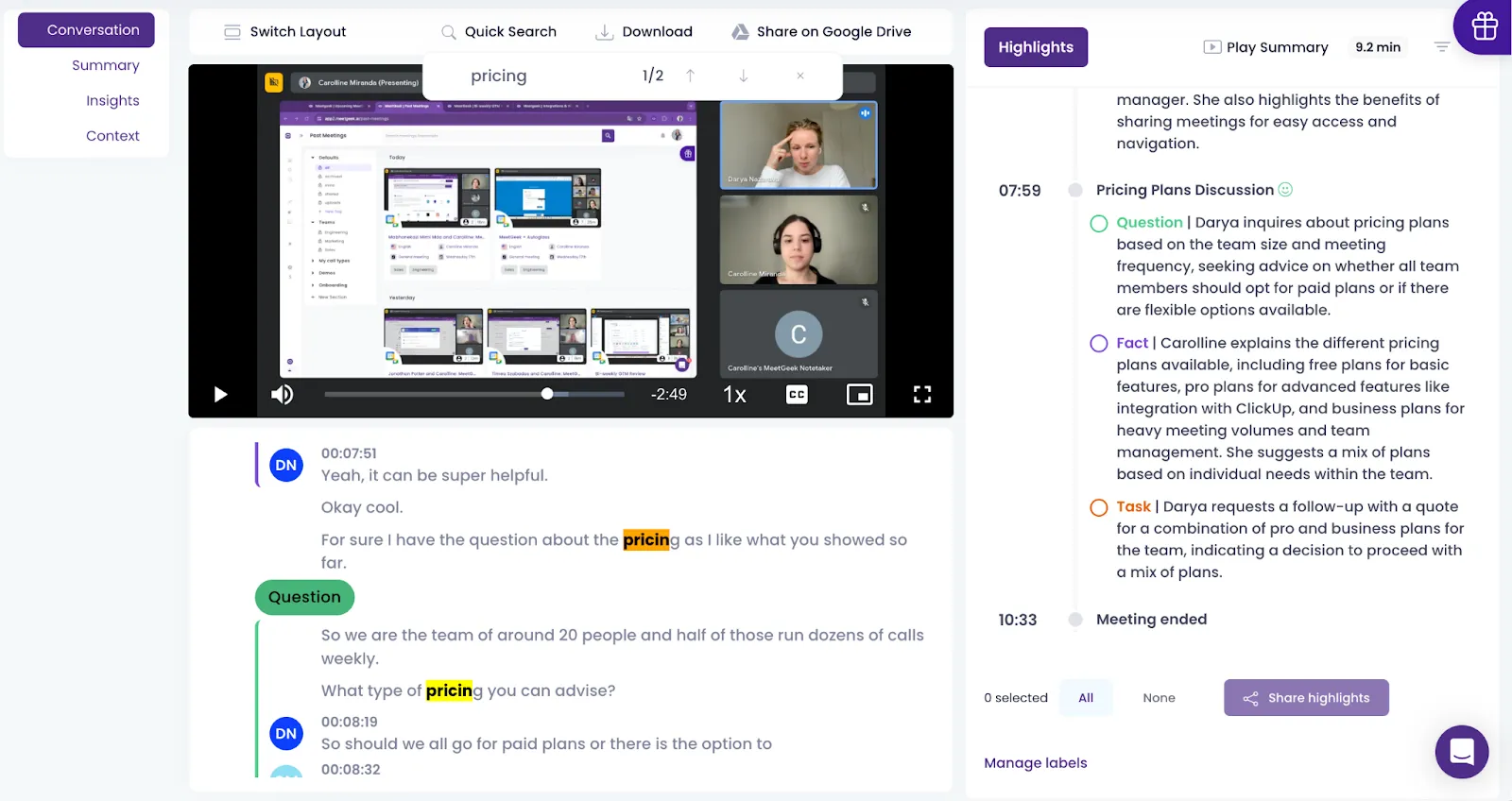
- Notas e comentários com data e hora: As notas e comentários com data e hora do MeetGeek permitem que as equipes trabalhem de forma assíncrona e forneçam feedback sobre partes específicas da reunião.
- Acompanhamentos eficientes: Configure fluxos de trabalho que enviem e-mails aos participantes da reunião Resumos gerados por IA, completo com itens de ação e principais conclusões, em poucos minutos após o término da conversa.
3. Transição para o Industry Talk
Comece a conversa discutindo o contexto mais amplo do setor do cliente. Você pode mencionar tendências, desafios ou oportunidades de crescimento atuais que você notou em sua pesquisa.
Lembre-se de incorporar terminologia e frases comuns no setor do cliente. Isso prova que você está familiarizado com a área deles e ajuda a criar um entendimento compartilhado, fazendo com que a conversa pareça mais natural e relevante para eles.
Por exemplo, se você estiver trabalhando com consultores financeiros, use termos como 'alocação de ativos, ''tolerância ao risco, 'ou “planejamento financeiro de longo prazo.'Da mesma forma, ao trabalhar com profissionais do setor imobiliário, use termos como'avaliação de propriedades, ''valorização do capital, 'ou'taxas de hipoteca.'
4. Faça perguntas abertas
Depois que suas bases estiverem cobertas, você poderá fazer uma transição suave para suas perguntas. Enquadre-os de uma forma que evite levar o cliente potencial a uma resposta específica. O objetivo é permitir que eles expressem sua perspectiva livremente, sem se sentirem pressionados em uma direção específica.
Depois de fazer sua pergunta aberta, evite se apressar com mais informações ou preencher o silêncio. Dê ao seu cliente em potencial tempo para pensar e responder. Isso incentiva respostas mais profundas e ponderadas.
Depois que eles responderem, desenvolva suas respostas fazendo perguntas complementares que aprofundem o tópico. Isso mostra que você está ouvindo com atenção e quer explorar seus desafios e necessidades mais detalhadamente.
5. Pratique a escuta ativa durante as sessões de descoberta
A escuta ativa é fundamental para o sucesso do processo de descoberta, portanto, você deve prestar toda a atenção — eliminar distrações, manter contato visual (se for uma videochamada) e mostrar que está ouvindo com pequenos sinais verbais, como”Eu vejo” ou acenando com a cabeça.
Em primeiro lugar, abandone as anotações manuais. Além de distrair a conversa real, também pode ser muito impreciso e subjetivo. Em vez disso, tente usar uma plataforma de automação de reuniões virtuais como Conheça o Geek para transcrever e resumir automaticamente sua reunião enquanto você presta total atenção ao cliente potencial.
Além disso, deixe o cliente potencial terminar suas ideias antes de responder para garantir que você entenda totalmente o ponto de vista dele. Quando terminarem, parafraseie o que você ouviu para confirmar sua compreensão, por exemplo: “Então, seu principal desafio é encontrar uma solução que se adapte à sua equipe, certo?” Se alguma coisa não estiver clara, faça perguntas complementares para obter mais detalhes.
6. Preste atenção às filas não verbais
Sinais não verbais podem dizer tanto, se não mais, do que o que está sendo dito em uma reunião de descoberta.
Preste muita atenção ao como o cliente potencial se posiciona. Eles estão se inclinando, demonstrando interesse ou se inclinando para trás, o que pode indicar desengajamento? Braços cruzados podem indicar desconforto ou hesitação, enquanto posturas abertas podem sugerir que eles são receptivos às suas ideias.
Além disso, expressões muitas vezes revelam como alguém se sente em relação à conversa. Sorrir, acenar com a cabeça ou levantar as sobrancelhas pode indicar concordância ou interesse. Por outro lado, sobrancelhas franzidas, franzir a testa ou falta de expressão podem significar confusão ou dúvida. Use esses sinais para ajustar sua abordagem ou fazer perguntas esclarecedoras.
Por fim, ouça o cliente potencial tom. Se eles ficarem mais entusiasmados, talvez estejam particularmente interessados no que você está discutindo. Se o tom deles parecer hesitante ou incerto, vale a pena fazer uma pausa para resolver quaisquer preocupações que eles possam ter.
DICA PROFISSIONAL: Assim como você lê as dicas deles, eles estão lendo as suas. Mantenha uma linguagem corporal aberta e acolhedora, use expressões faciais que mostrem que você está engajado e mantenha um tom amigável e profissional durante toda a reunião.
7. Mantenha sua proposta de valor concisa
Ao liderar uma reunião de descoberta, mantenha sua proposta de valor curta e focada. O cliente potencial está lá para compartilhar suas necessidades e aprender como você pode ajudar. Portanto, ser claro e conciso garante que ele entenda sua oferta sem se sentir sobrecarregado.
Veja como manter sua proposta de valor concisa:
- Concentre-se nas necessidades do cliente potencial: Adapte sua proposta de valor para abordar os desafios e metas específicos que o cliente potencial compartilhou com você. Isso mantém sua mensagem relevante e mostra que você entende a situação deles.
- Destaque os principais benefícios, não os recursos: Em vez de listar todos os recursos do seu produto ou serviço, concentre-se nos principais benefícios que ele oferece. Mantenha a simplicidade e destaque como isso resolve o problema deles.
- Use uma linguagem simples: Evite jargões ou termos excessivamente técnicos — sua proposta de valor deve ser fácil de entender e ir direto ao ponto.
- Seja breve: Sua proposta de valor não precisa ser longa para ser eficaz. Uma frase ou duas são suficientes para explicar como você pode ajudar sem desperdiçar o valioso tempo do cliente potencial.
8. Aborde os pontos problemáticos do seu cliente potencial
Quando o cliente potencial explicar suas dificuldades, mostre que você está realmente ouvindo, o que ajuda a criar confiança e uma conexão. Por exemplo, você pode dizer: “Eu entendo como gerenciar vários projetos ao mesmo tempo pode ser complicado, especialmente sem as ferramentas certas.”
Em seguida, faça perguntas complementares. Uma pergunta como: “Que impacto isso está tendo na produtividade da sua equipe?” os ajuda a se abrirem sobre as reais consequências com as quais estão lidando.
Depois de entender completamente seus pontos problemáticos, adapte sua solução para lidar com esses desafios específicos. Por exemplo, “Nossa plataforma pode ajudar a reduzir o tempo que sua equipe gasta em tarefas manuais, permitindo que ela se concentre no trabalho de maior prioridade.” Uma resposta direcionada garante ao cliente potencial que você está alinhado com as necessidades dele.
Também é útil compartilhar histórias de sucesso relevantes se você trabalhou com clientes que enfrentam desafios semelhantes, fornecendo ao cliente potencial exemplos reais de como sua abordagem funcionou para outras pessoas.
Por fim, depois de apresentar sua solução, verifique se ela está alinhada com o que o cliente potencial está procurando. Uma pergunta simples como: “Essa abordagem parece uma boa opção para enfrentar seus desafios?” mantém a conversa aberta e garante que você esteja na mesma página.
9. Lidar com objeções profissionalmente
Lidar com objeções durante uma reunião de descoberta é uma parte natural da conversa. Quando um cliente potencial levantar preocupações, aborde-as com calma e profissionalismo, transformando objeções em oportunidades de criar confiança.
Em primeiro lugar, uma vez que o cliente em potencial expresse sua preocupação, reconheça-a. Isso ajuda a criar um relacionamento e mostra que você não está descartando o ponto de vista deles. Você pode dizer algo como: “Eu entendo por que o orçamento é uma preocupação para seu planejamento financeiro e é importante garantir que qualquer solução ofereça valor a esse investimento.”
Em seguida, ofereça uma solução ou esclarecimento que aborde diretamente a objeção. Se o problema for o custo, por exemplo, você pode destacar o valor a longo prazo ou o retorno potencial do investimento. Por exemplo, “Embora o custo inicial possa parecer alto, os clientes descobriram que nossa solução reduz os custos operacionais em 30% no primeiro ano, tornando-a um investimento que vale a pena.”
Se a objeção se referir a recursos ou capacidades, explique como seu serviço ou produto pode resolver seus pontos problemáticos específicos. Apoiar suas reivindicações com estudos de caso ou exemplos de clientes semelhantes pode fortalecer sua resposta.
Por fim, entre em contato com o cliente potencial para garantir que sua resposta tenha abordado a preocupação dele. Isso mantém a conversa aberta e mostra que você está empenhado em resolver as objeções deles.
10. Decida as próximas etapas
Decidir quais são as próximas etapas claras no final de uma reunião de descoberta mantém o ritmo e garante que todos saibam o que vem a seguir.
Mas antes de passar para as próximas etapas, recapitule brevemente os principais pontos discutidos durante a reunião. Isso confirma que você e o cliente potencial estão na mesma página e oferece a oportunidade de esclarecer qualquer coisa, se necessário.
Em seguida, pergunte ao cliente potencial o que ele espera alcançar no curto prazo e como ele imagina trabalhar em conjunto. Com base na discussão, você também pode sugerir próximas etapas específicas, como agendar uma reunião de acompanhamento, enviar uma proposta ou configurar uma demonstração. Seja claro sobre o que precisa acontecer a seguir e quando.
Além disso, descreva quem será responsável por cada item de ação, seja fornecendo mais informações, coletando feedback interno ou organizando uma reunião de acompanhamento. Não se esqueça de estabelecer um cronograma claro para quando as próximas etapas serão concluídas. Isso mantém o projeto avançando na direção certa.
Como aumentar as oportunidades de vendas após uma reunião do Discovery
Quando a sessão inicial de descoberta for concluída, há várias coisas que você pode fazer para ampliar sua eficácia.
Veja como aumentar as oportunidades de vendas após uma reunião de descoberta:
- Envie um e-mail de acompanhamento logo após a reunião
- Converse com sua equipe
- Responda a quaisquer perguntas pendentes
- Use a gravação da reunião para refinar seu processo de descoberta
1. Envie um e-mail de acompanhamento logo após a reunião
Enviando um e-mail de acompanhamento logo após uma reunião de descoberta é uma das formas mais eficazes de manter a conversa viva e transformar a conexão inicial em uma potencial oportunidade de vendas.
O tempo é importante: enviar o e-mail em 24 horas ajuda a manter a discussão fresca na mente do cliente potencial e mostra que você é proativo em levar as coisas adiante.
Comece seu e-mail expressando gratidão pelo tempo e pelas ideias que eles tiveram durante a reunião. Algo simples como, “Obrigado por dedicar seu tempo para se encontrar comigo hoje,” define um tom positivo e mostra que você valoriza o esforço que eles colocam na conversa.
A partir daí, ofereça uma breve recapitulação dos principais pontos discutidos. Isso ajuda a confirmar que você está na mesma página e lembra o cliente potencial dos principais pontos problemáticos e metas abordados no processo de descoberta de vendas. Por exemplo, “Como discutimos, melhorar os cronogramas do projeto e simplificar o fluxo de trabalho são as principais prioridades no momento.”
Em seguida, descreva claramente as próximas etapas. Se você concordou em enviar uma proposta, agendar uma ligação de acompanhamento ou organizar uma demonstração do produto, reafirmar essas etapas ajuda a manter a clareza e a manter as coisas na direção certa.
Por exemplo, você pode dizer: “Enviarei uma proposta até sexta-feira e poderemos nos reconectar na próxima semana para resolver qualquer dúvida que você possa ter.”
Para agregar valor, considere incluir algo extra que possa ser útil para eles. Pode ser um artigo relevante, um estudo de caso de um cliente similar ou um recurso do produto que se alinhe às suas necessidades.
Por fim, encerre o e-mail com uma chamada à ação amigável, convidando-os a entrar em contato se tiverem alguma dúvida ou precisarem de esclarecimentos. Diga a eles que você está aqui para ajudar e está comprometido em encontrar a solução certa para seus negócios.
DICA PROFISSIONAL: Alternativamente, deixe Conheça o Geek faça isso por você, para que você possa pular todo o trabalho extra e se concentrar no que importa: aprender mais sobre seus clientes potenciais. O MeetGeek usa algoritmos avançados de IA que criam e-mails de acompanhamento contendo todas as informações relevantes da reunião, incluindo itens de ação, resumos ou até mesmo transcrições inteiras.
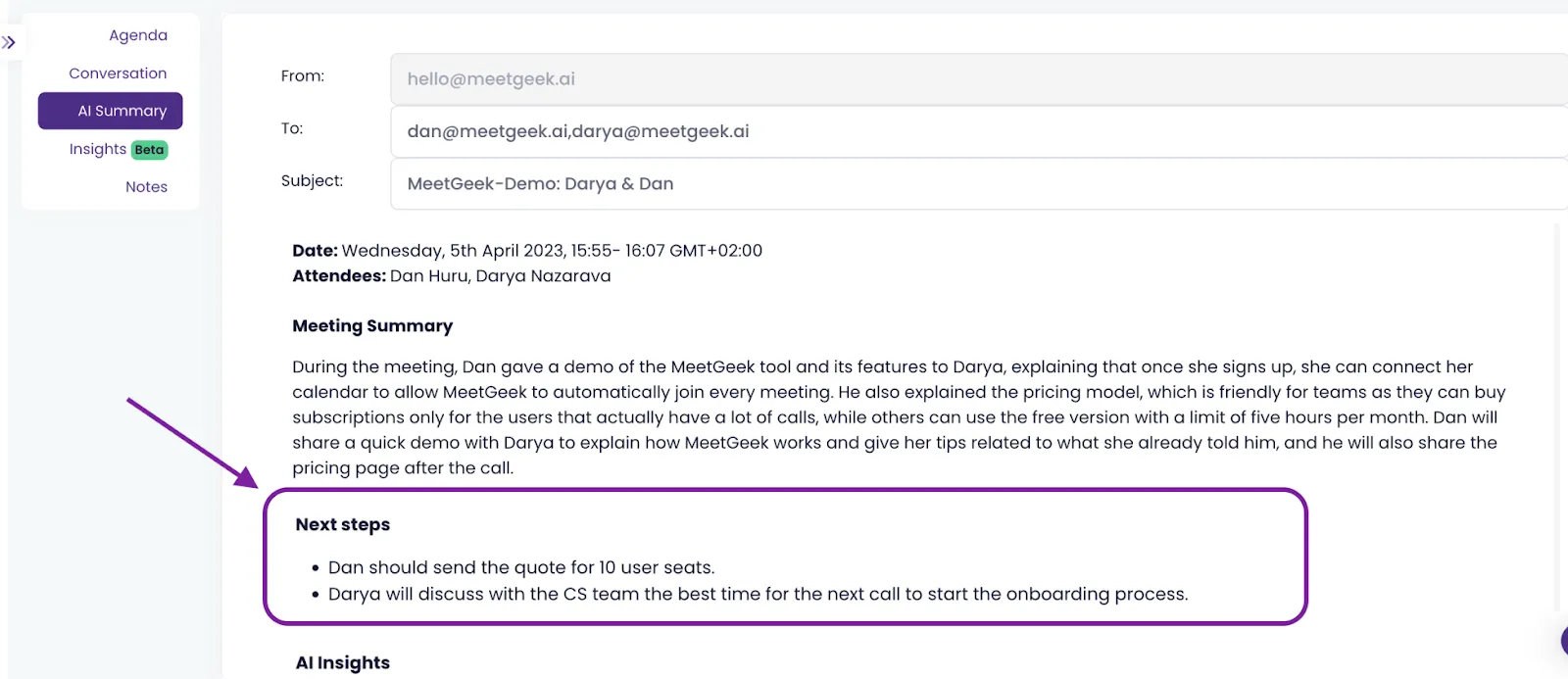
2. Converse com sua equipe
Conversar com sua equipe após uma reunião de descoberta é fundamental para garantir que todos estejam prontos para traçar a melhor estratégia a seguir.
Comece o interrogatório examinando os principais pontos problemáticos, as metas e as preocupações levantadas pelo cliente potencial. Em seguida, discuta as necessidades específicas do cliente potencial e quão bem sua solução atende a essas necessidades. Esse também é um bom momento para explorar se são necessários ajustes ou serviços adicionais para atender às expectativas.
Além disso, fale sobre quaisquer objeções ou preocupações levantadas durante a reunião. Faça um brainstorming possíveis desafios no processo de vendas e discuta como enfrentá-los de forma proativa.
Defina claramente as próximas etapas para acompanhar o cliente potencial. Seja enviando uma proposta, agendando uma demonstração ou reunindo informações adicionais, certifique-se de que todos conheçam suas funções e responsabilidades.
Adaptar sua abordagem com base nos insights da reunião pode fazer uma grande diferença na construção de relacionamento e confiança com o cliente potencial. Pense em como você pode melhorar sua comunicação ou oferta com base no que aprendeu durante a reunião de descoberta.
DICA PROFISSIONAL: Para uma abordagem simplificada em sua equipe, use Conheça o Geek's Meeting Templates para personalizar os resumos e insights capturados durante a chamada de descoberta com sua equipe, para que você esteja em sincronia com as solicitações e necessidades dos clientes.

3. Responda a quaisquer perguntas pendentes
Depois de uma reunião de descoberta, é comum que os clientes potenciais tenham perguntas que não foram totalmente abordadas ou surgiram após a discussão.
Ao abordar questões pendentes, forneça respostas claras que abordem diretamente as preocupações do cliente potencial. Evite sobrecarregá-los com muitas informações, mas certifique-se de que sua resposta seja completa o suficiente para resolver suas dúvidas.
Além disso, sempre vincule suas respostas aos principais pontos problemáticos e metas do cliente potencial para manter o foco em como sua solução atende às necessidades dele e ajuda a reforçar o valor que você oferece.
Depois de responder às perguntas, deixe a conversa aberta para mais diálogo, mostrando ao cliente potencial que você está comprometido em apoiá-lo durante todo o processo de tomada de decisão.
4. Use a gravação da reunião para refinar seu processo de descoberta
Depois de uma reunião de descoberta, assista à gravação, concentrando-se em como a conversa fluiu. Preste atenção às áreas em que a discussão ocorreu sem problemas e onde ela pode ter parado. Isso o ajudará a identificar os pontos da reunião em que você poderia fazer perguntas melhores ou ajustar sua abordagem.
Em seguida, avalie como você lidou com as preocupações e objeções do cliente potencial. Você conseguiu lidar com seus pontos problemáticos de forma eficaz ou houve momentos em que poderia ter feito melhor? Aprender com essas interações ajuda você a refinar suas respostas para futuras reuniões.
Além disso, procure dicas do cliente potencial que você possa ter perdido durante a reunião ao vivo. Isso pode incluir sinais não verbais ou dicas sutis sobre suas prioridades que você não explorou totalmente.
Se você puder, compartilhe o Conheça o Geek gravando com sua equipe para obter feedback. Um novo olhar pode fornecer perspectivas valiosas sobre como você conduziu a reunião e oferecer ideias para melhorias.
Além disso, com o MeetGeek, você também obtém insights personalizados de acordo com as métricas mais importantes para sua equipe, para que você possa ver as áreas específicas em que pode melhorar.
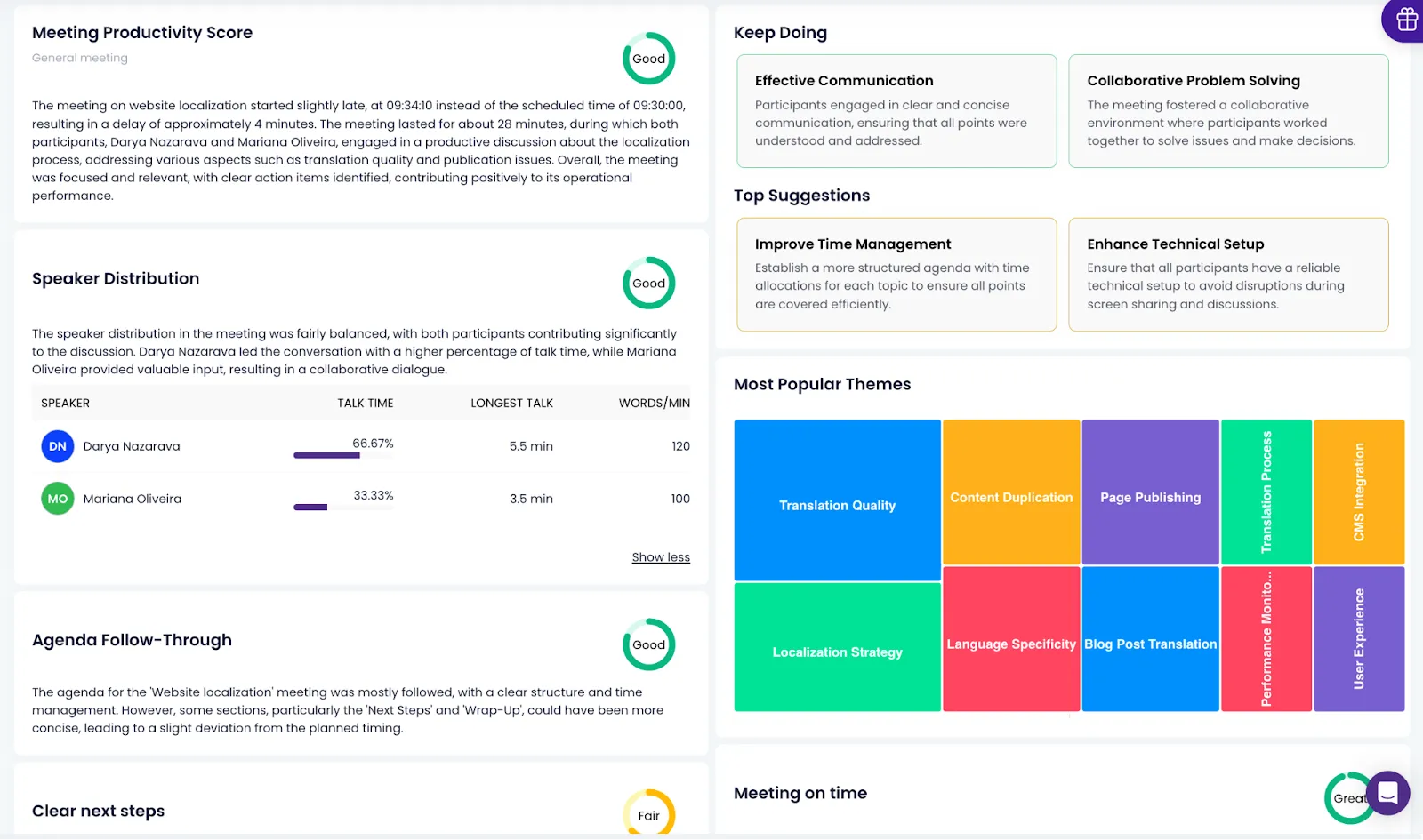
Deixe o MeetGeek lidar com suas reuniões de descoberta!
Realizar uma reunião de descoberta eficaz tem tudo a ver com preparação, comunicação clara e acompanhamento eficaz. Ao entender as necessidades do seu cliente potencial, fazer as perguntas certas e abordar as preocupações profissionalmente, você pode estabelecer a base para uma parceria bem-sucedida.
Se você deseja simplificar e aprimorar suas reuniões de descoberta, deixe o MeetGeek cuidar disso por você! Com gravação automática, transcrição e resumos de reuniões, o MeetGeek permite que você se concentre na construção de relacionamentos enquanto cuidamos dos detalhes. Experimente o MeetGeek hoje e leve suas reuniões de descoberta para o próximo nível!
.avif)





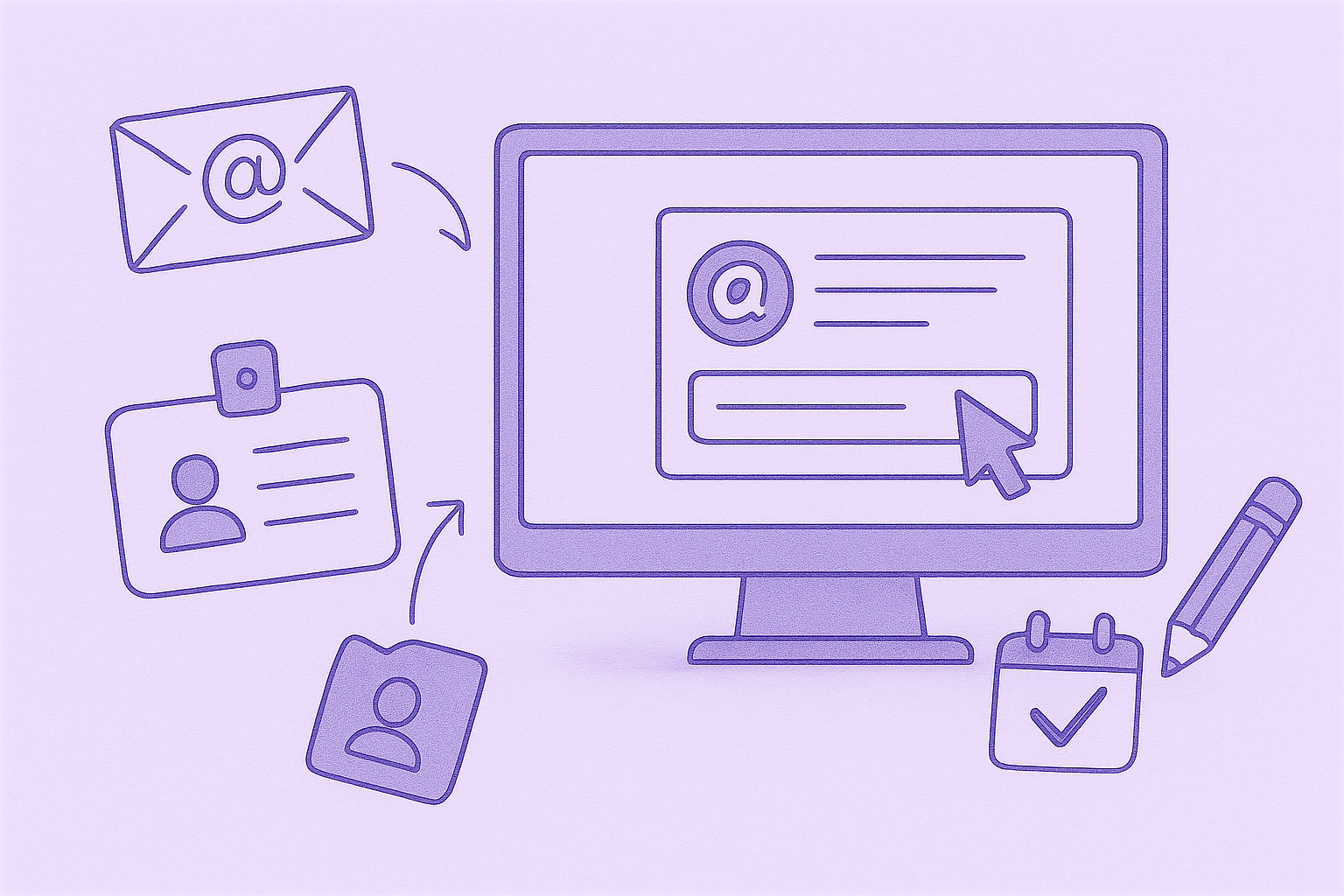
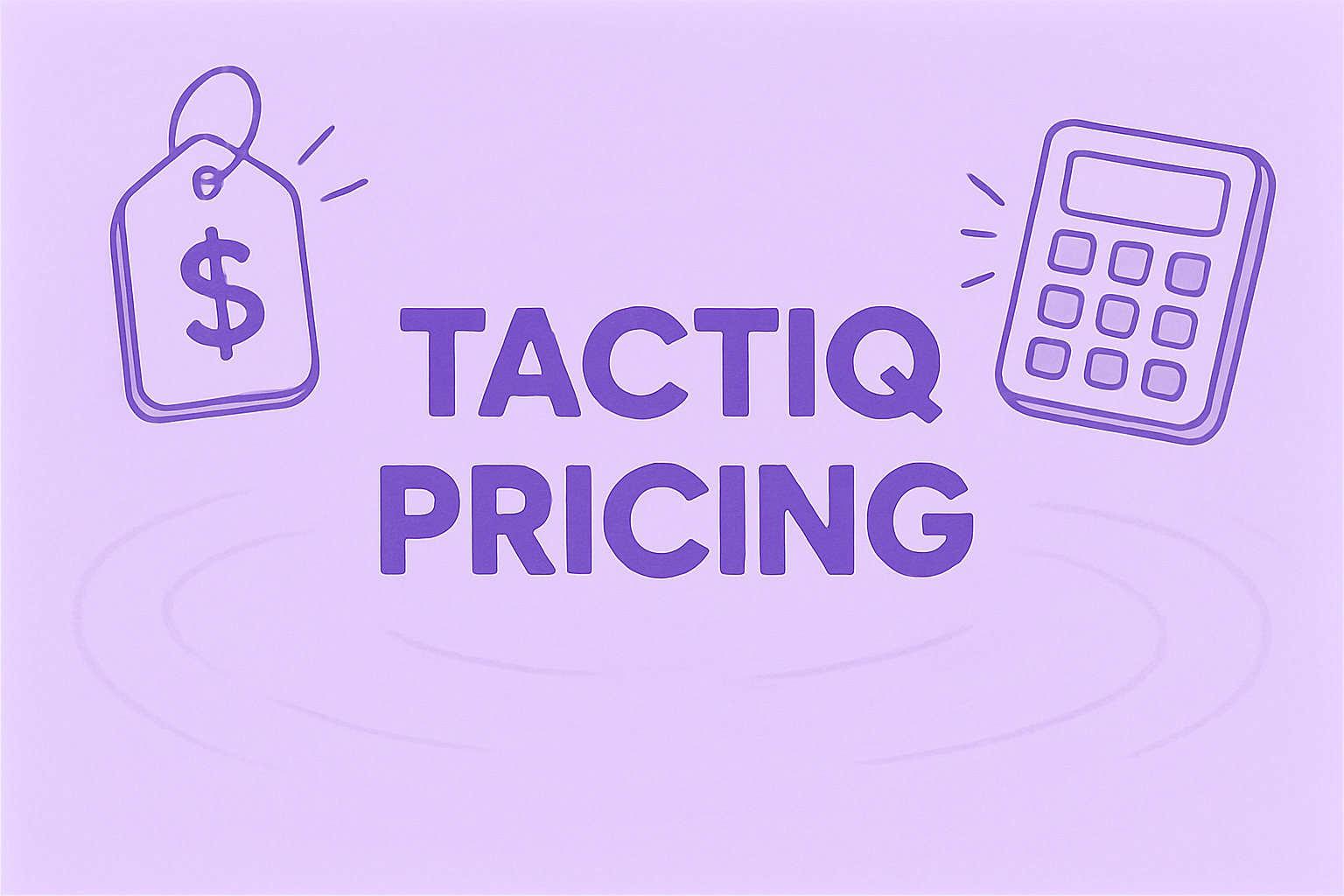
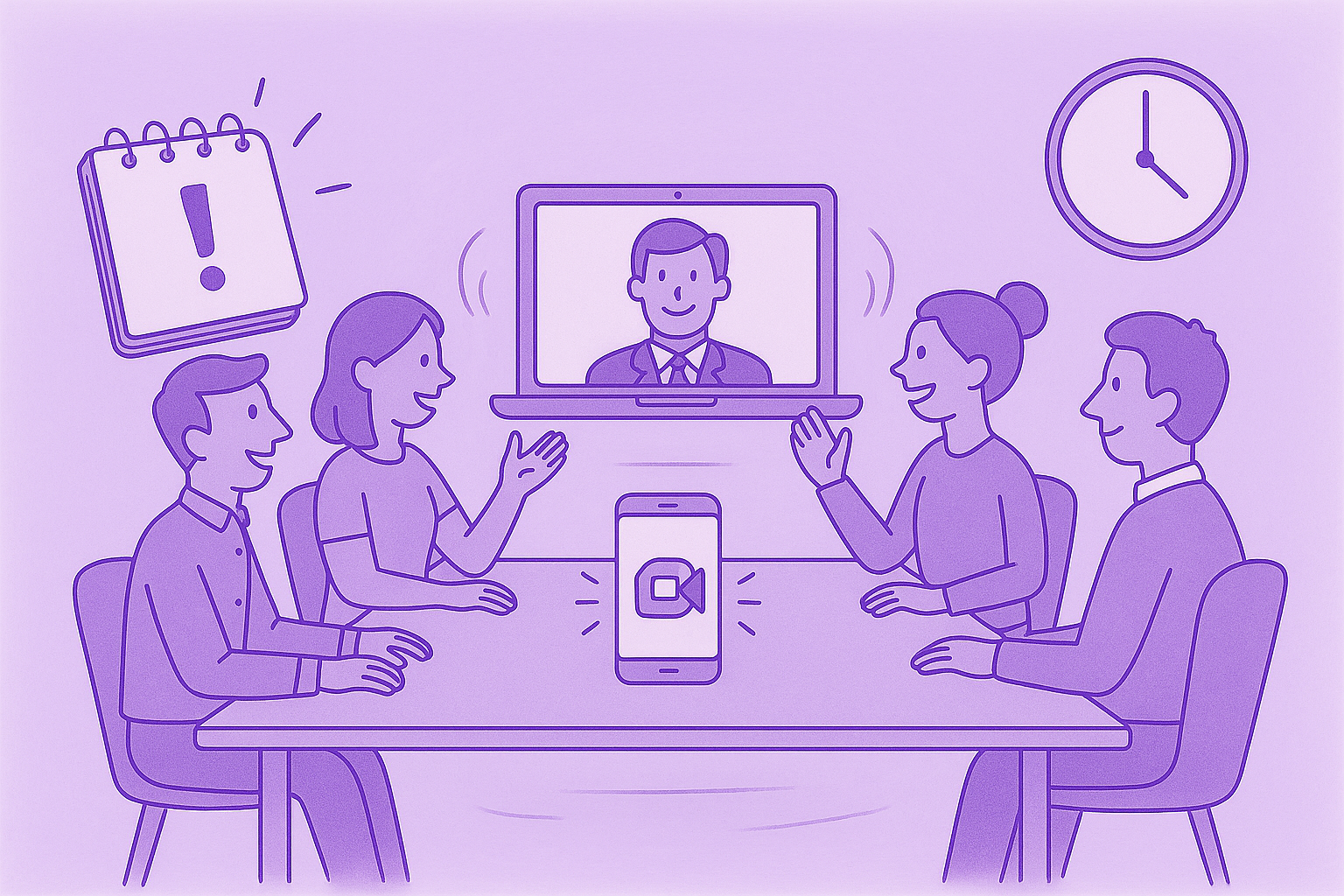
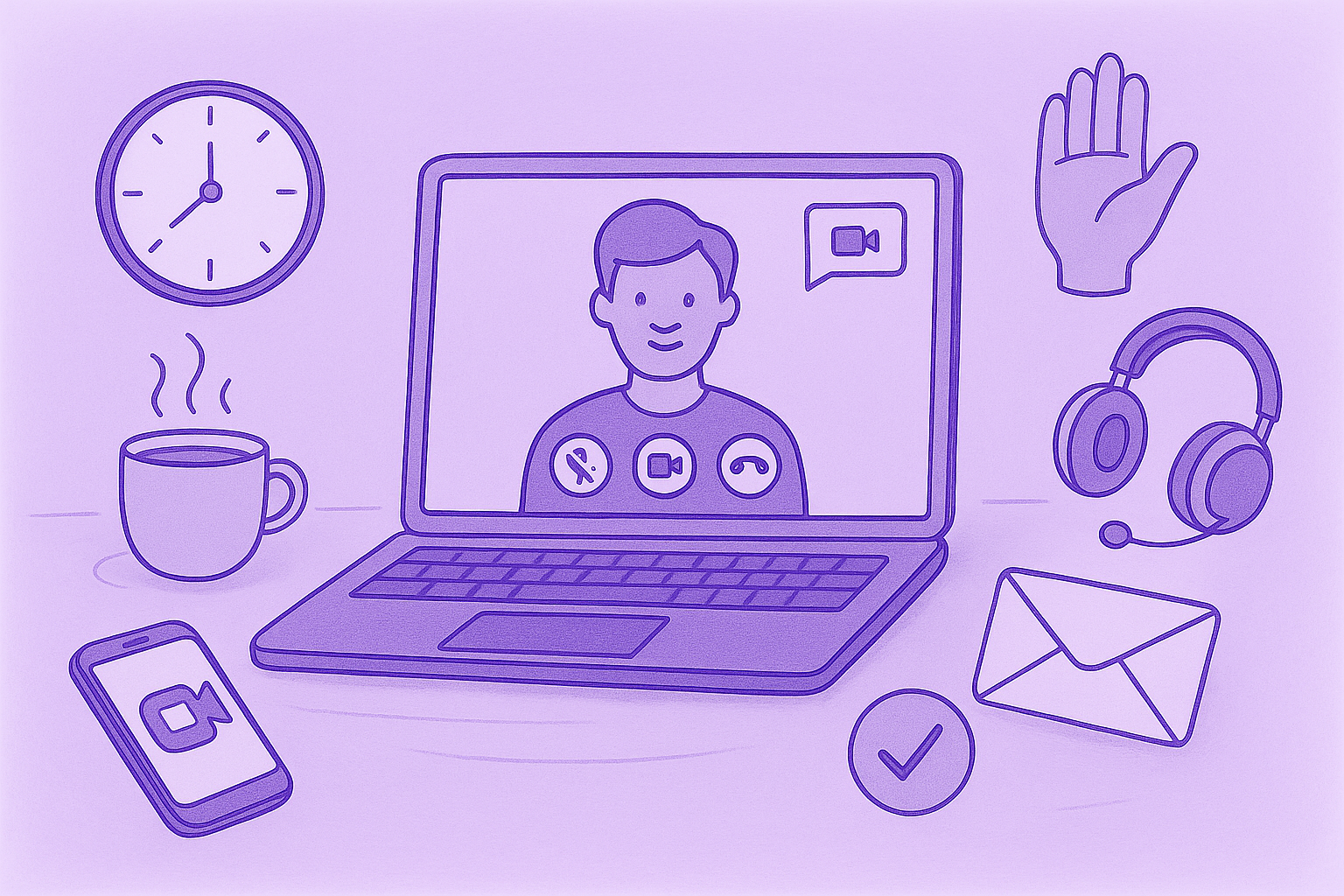
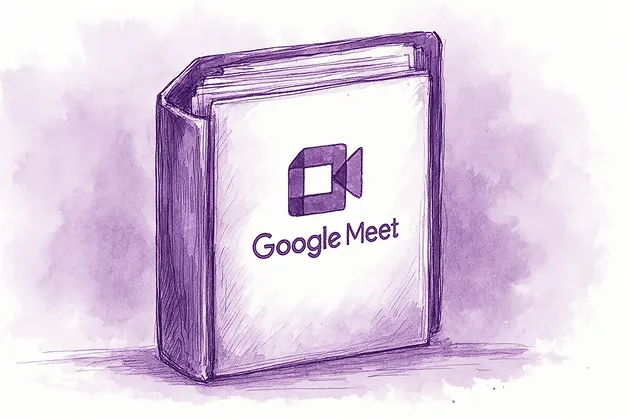


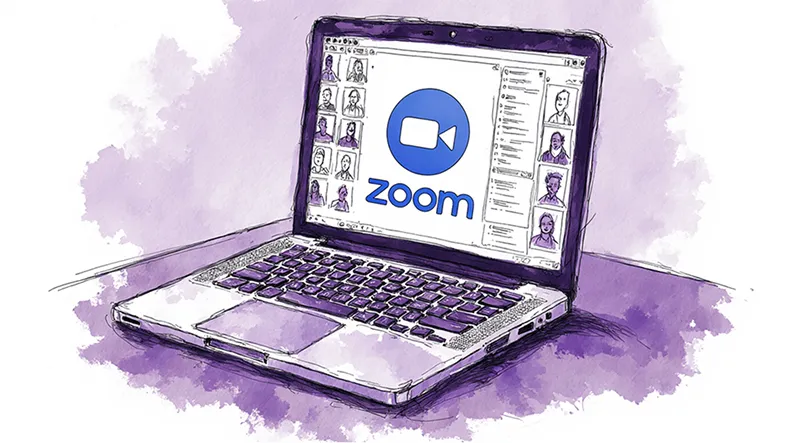
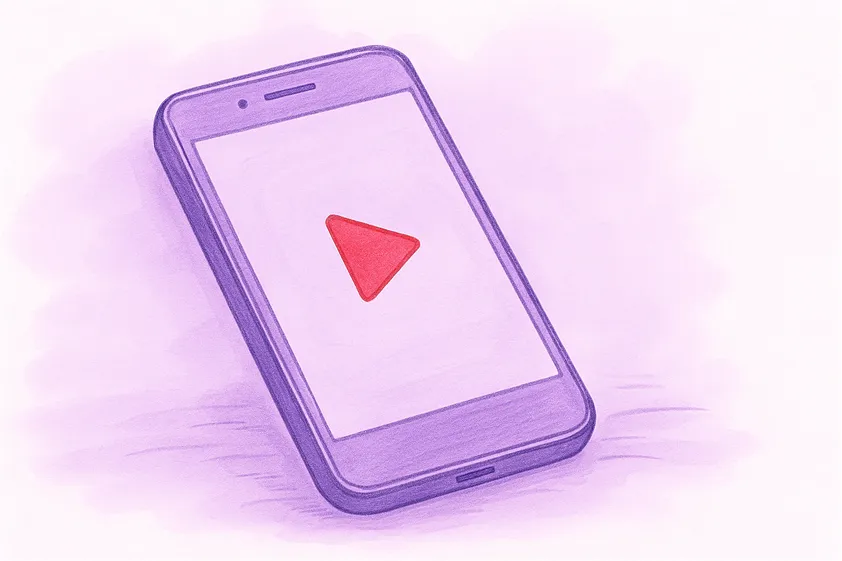






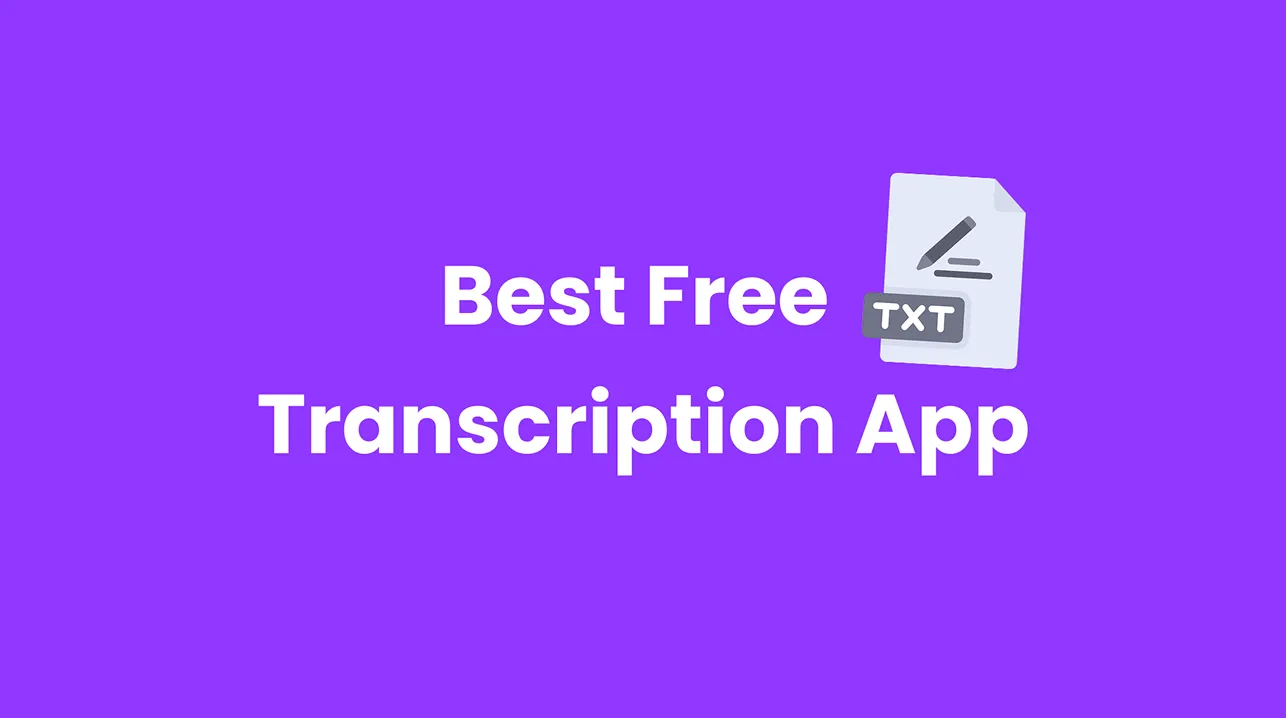



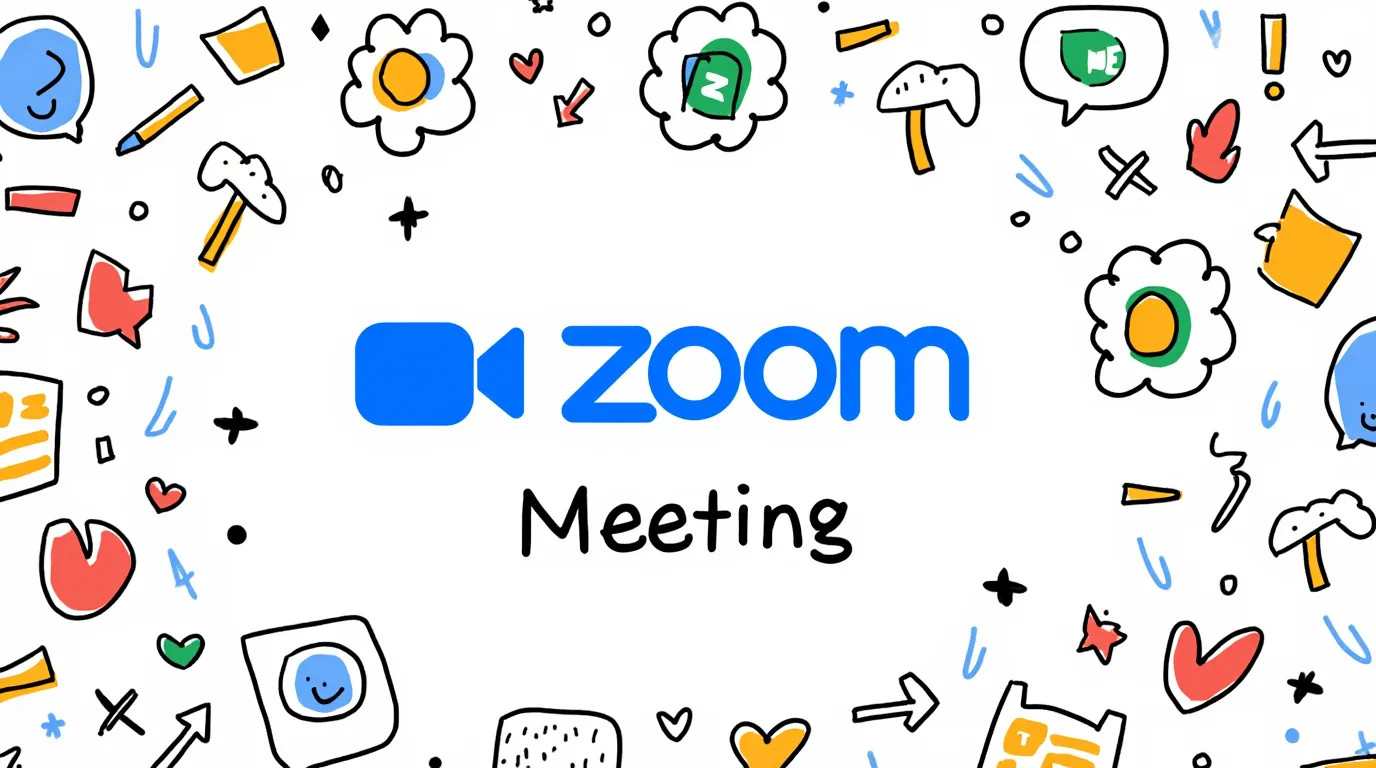
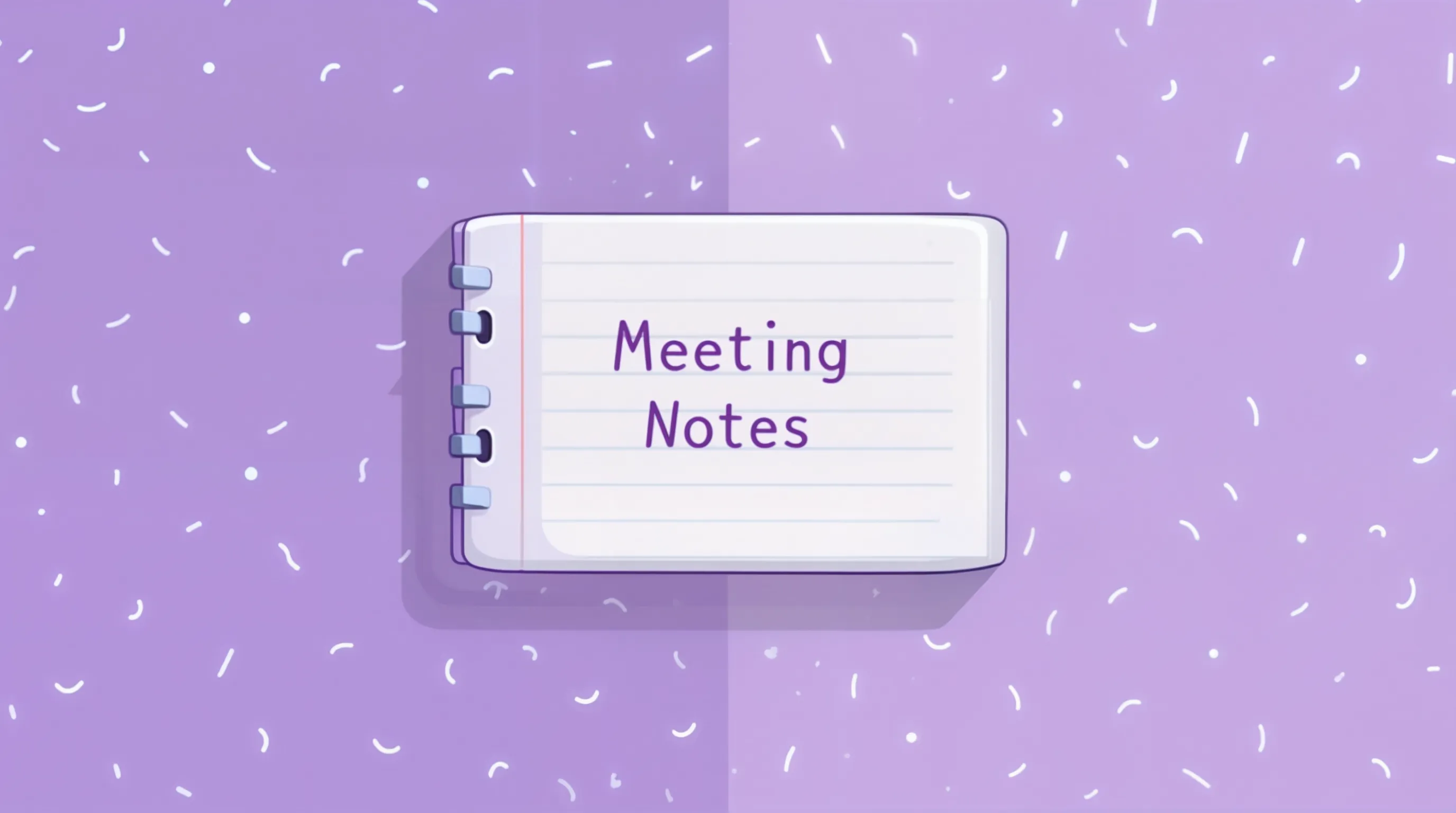








.webp)
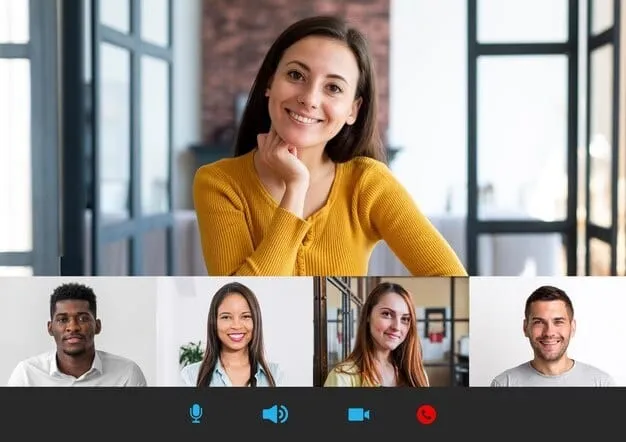


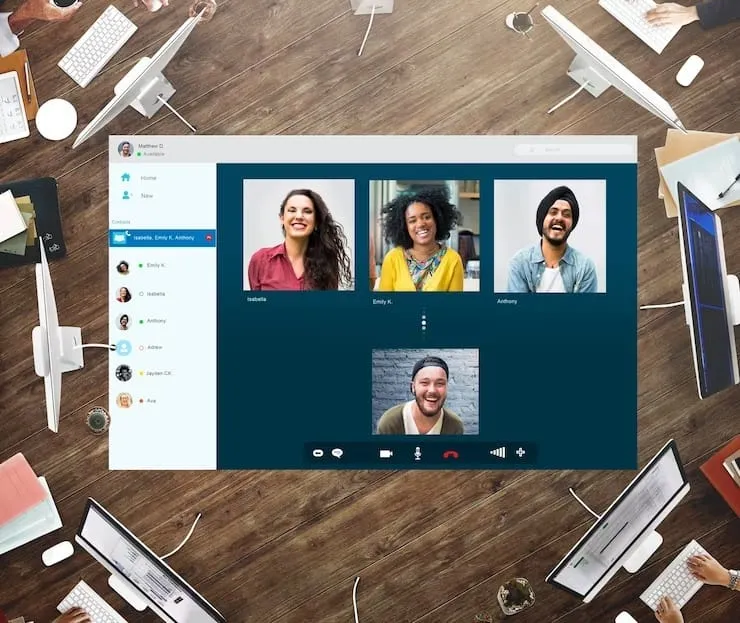
.jpeg)
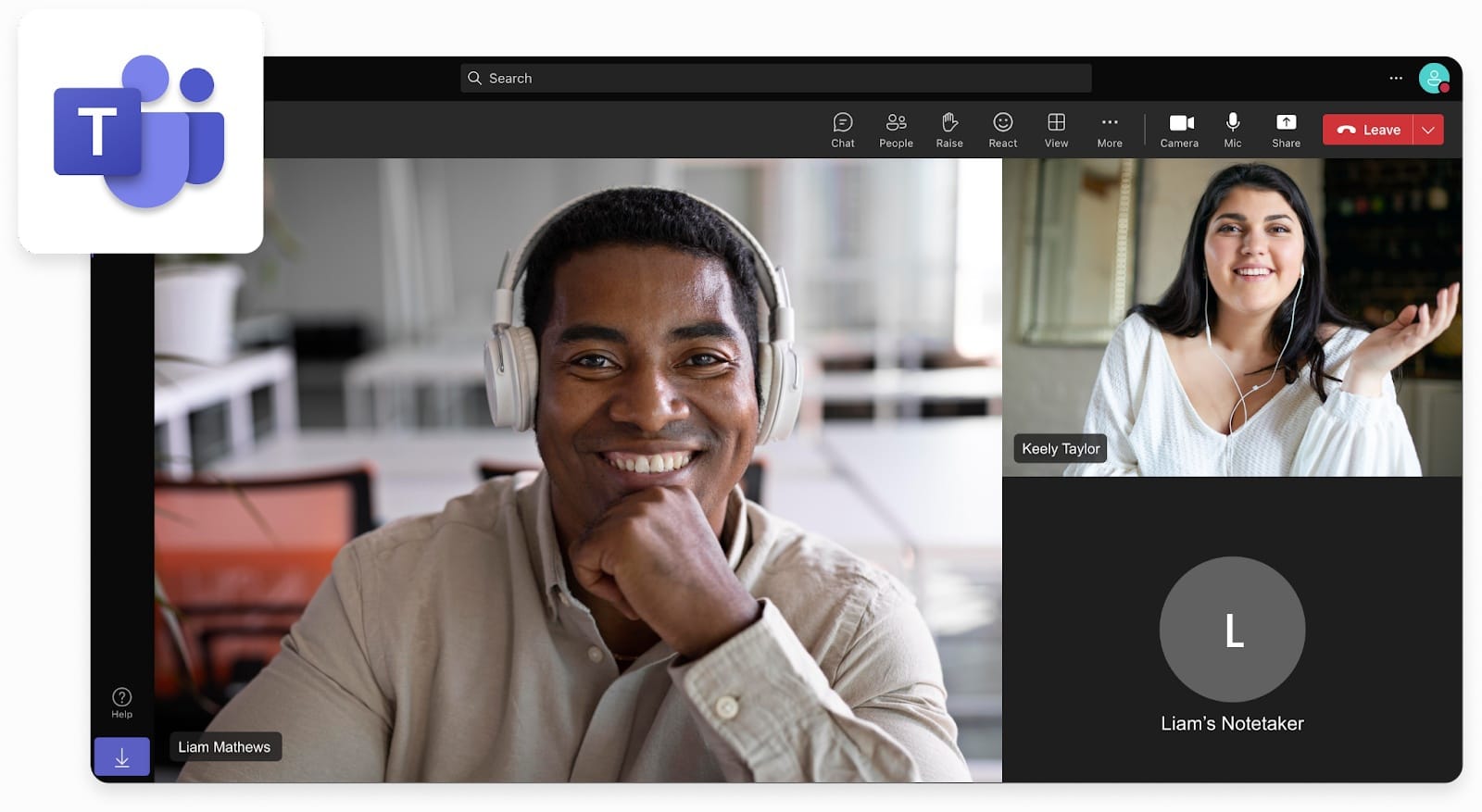





.jpeg)





.jpg)

.webp)



.jpeg)










